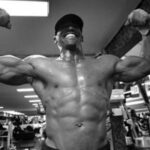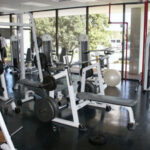Bicep curls are one of the most basic exercises in weightlifting. They may be performed with either dumbbells or a barbell. There are a number of different ways to perform bicep curls in order to concentrate on different areas of the muscle or improve the range of motion, which I will cover during the course of this article.
First, let us begin with how to do a standard barbell bicep curl. Bicep curls are best performed in four or five sets of around eight reps a piece. If you can, try to add weight to the barbell bar or dumbbells after each set in order to create a workload of progressive resistance. First, start with a low weight that will allow the biceps a chance to properly warm up and get used to the stress being placed on them. It is never a good idea to start with a heavy weight in any weight lifting exercise unless you are properly warmed up. After completing a set, take between one and three minutes rest to allow your muscles recovery but not too long as to make them cool down.
Place your feet about shoulder width apart, bend your knees and pick up the barbell with an underhand grip (palms facing up). Make sure that your back remains straight and in a neutral position. Lift with your legs, not with your back. Now, allow the barbell to dangle at arms length in front of you. Moving nothing but your forearms, slowly curl the bar up toward your chest, exhaling as you go. Give your biceps an additional squeeze at the top of the movement, then lower the bar back to starting position, resisting all the way down. By resisting the weight with your muscles on the way down, you will help to work your muscles in a full range of movement and improve the results of your overall workout. It is important to remember to keep your upper arms and elbows stationary at your side. If you move your elbows forward, you will be displacing the brunt of the weight to the front deltoids (shoulder muscles) and won’t be hitting the bicep heads.
For a variation of barbell bicep curls, you can do the exact same motion with an overhand grip (palms down). These are called reverse barbell curls, and are useful in not only working the biceps, but also the muscles of the forearms. The extensors in the forearm are especially affected by this exercise.
With bicep curls using dumbbells, there are a number of variations. First, we will cover standing dumbbell curls. Stand like you were at the beginning of the barbell curls, with feet spaced about shoulder length apart and the weights at your sides. Make sure for dumbbell curls you begin with your palms facing your hips while they rest at your side. Now, concentrating on moving only the forearms in an upward arc, curl the weights upwards. As you lift, twist your hands in a smooth motion so that at the top of the movement, your palms are facing upward. Using this movement will allow the biceps to work in their full range of motion. Not only are the biceps used to flex the arm, they are also used to twist the hand in a pouring motion.
There are certain variations for dumbbell curls. The most basic involves sitting down on a bench instead of standing up to perform the movement. Sitting down offers the advantage of greater control over the weights as you are lifting since you can’t call upon your legs or lower back to cheat. Another variation involves how you hold the dumbbells. When you begin with your palms facing your hips, do not twist your hand as you begin to draw the weights upwards. This is known as a hammer curl, because the movement and position of the dumbbells resembles a hammer. This variation will help to work the forearms as well as the biceps.
Another variation involves the kind of bench you have available. If you have a bench that has incline or decline capability, then you can put it to work. If you put the bench on an incline and lean against it to do your dumbbell curls, you can work the bicep through a wider range of motion than you could if sitting or standing upright. Also, one of the best benches you can use for dumbbell curls is called a preacher bench. This is a bench that consists of a seat for the lifter, then an inclined pad that the lifter drapes his or her arms over to grasp the weight and curl it upwards. The preacher bench is one of the most effective ways to work the biceps because it prevents the elbows from moving at all, thus putting all of the stress on the bicep muscles. Preacher bench curls can also be performed with what is called an EZ bar, a zigzagged barbell bar that accommodates the hand grip more effectively on that particular bench. Make sure that before you attempt preacher curls, the seat is adjusted to the correct height. It should be adjusted to a height that you can comfortably reach the weights with, without being pulled off the seat by them. Leaving the seat is dangerous because it can put strain on your lower back during the lift.
That should get you started with bicep curls. As with any other weightlifting exercise, start out with small weights so that you can get your body and your mind used to the movements and strains involved. Rome wasn’t built in a day, and neither will your biceps, so just take it slow and steady.




